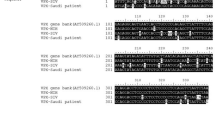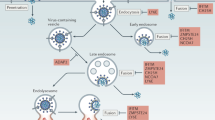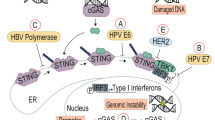Abstract
Viral regulatory proteins represent new targets for therapeutic and prevention strategies against HIV.
This is a preview of subscription content, access via your institution
Access options
Subscribe to this journal
Receive 12 print issues and online access
$209.00 per year
only $17.42 per issue
Buy this article
- Purchase on Springer Link
- Instant access to full article PDF
Prices may be subject to local taxes which are calculated during checkout
Similar content being viewed by others
References
Pantaleo, G. & Fauci, A.S. Immunopathogenesis of HIV infection. Annu. Rev. Microbiol. 50, 825–854 (1996).
Richman, D.D. Clinical significance of drug resistance in human immunodeficiency virus. Clin. Infect. Dis. 21 (Suppl. 2), S166–169 (1995).
Kestler, H.W. et al. Importance of the nef gene for maintenance of high virus loads and for development of AIDS. Cell 65, 651–662 (1991).
Wyand, M.S., Manson, K.H., Garcia-Moll, M., Montefiori, D. & Desrosiers, R.C. Vaccine protection by a triple deletion mutant of simian immunodeficiency virus. J. Virol. 70, 3724–3733 (1996).
Heinzinger, N.K. et al. The Vpr protein of human immunodeficiency virus type 1 influences nuclear localization of viral nucleic acids in nondividing host cells. Proc. Natl. Acad. Sci USA 91, 7311–7315 (1994).
Yao, X.-J. et al. Mutagenic analysis of human immunodeficiency virus type 1 Vpr: Role of a predicted N-terminal alpha-helical structure in Vpr nuclear localization and virion incorporation. J. Virol. 69, 7032–7044 (1995).
Dubrovsky, L. et al. Nuclear localization signal of HIV-1 as a novel target for therapeutic intervention. Mol. Med. 1, 217–230 (1995).
Jowett, J.B.M. et al. The human immunodeficiency virus type 1 vpr gene arrests infected T cells in the G2+M phase of the cell cycle. J. Virol. 69, 6304–6313 (1995).
He, J. et al. Human immunodeficiency virus type 1 viral protein R (Vpr) arrests Cells in the G2 phase of the cell cycle by inhibiting p34cdc2 activity. J. Virol. 69, 6705–6711 (1995).
Re, F., Braaten, D., Franke, E.K. & Luban, J. Human immunodeficiency virus type 1 Vpr arrests the cell cycle in G2 inhibiting the activation of p34cdc2-cyclin B. J. Virol. 69, 6859–6864 (1995).
DiMarzio, P., Choe, S., Ebright, M., Knoblauch, R. & Landau, N.R. Mutational analysis of cell cycle arrest, nuclear localization, and virion packaging of human immunodeficiency virus type 1 Vpr. J. Virol. 69, 7909–7916 (1995).
Bartz, S.R., Rogel, M.E. & Emerman, M. Human immunodeficiency virus type 1 cell cycle control: Vpr is cytostatic and mediates G2 accumulation by a mechanism which differs from DNA damage checkpoint control. J. Virol. 70, 2324–2331 (1996).
Wei, X. et al. Viral dynamics in human immunodeficiency virus type 1 infection. Nature 373, 117–122 (1995).
Ho, D.D. et al. Rapid turnover of plasma virions and CD4 lymphocytes in HIV-1 infection. Nature 373, 123–126 (1995).
Levy, D.N., Fernandes, L.S., Williams, W.V. & Weiner, D.B. Induction of cell differentiation by human immunodeficiency virus 1 Vpr. Cell 72, 541–550 (1993.
Maldarelli, F., Chen, M.Y., Willey, R.L. & Strebel, K. Human immunodeficiency virus type 1 Vpu protein is an oligomeric type 1 integral membrane protein. J. Virol. 67, 5056–5061 (1993).
Willey, R.L., Maldrelli, F., Martin, M.A. & Strebel, K. Human immunodeficiency virus type 1 Vpu protein induces rapid degradation of CD4. J. Virol. 66, 7193–7200 (1992).
Bour, S., Schubert, U. & Strebel, K. The human immunodeficiency virus type 1 Vpu protein specifically binds to the cytoplasmic domain of CD4: Implications for the mechanism of degradation. J. Virol. 69, 1510–1520 (1995).
Yao, X.-J. et al. Degradation of CD4 induced by human immunodeficiency virus type 1 Vpu protein: A predicted alpha-helix structure in the proximal cytoplasmic region of CD4 contributes to Vpu sensitivity. Virology 209, 615–623 (1995).
Göttlinger, H.G., Dorfman, T., Cohen, E.A. & Haseltine, W.A. Vpu protein of human immunodeficiency virus type 1 enhances the release of capsids produced by gag gene constructs of widely divergent retroviruses. Proc. Natl. Acad. Sci. USA 90, 7381–7385 (1993).
Ewart, G.D., Sutherland, T., Gage, P.W. & Cox, G.B., Vpu protein of human immunodeficiency virus type 1 forms cation-selective ion channels. J. Virol. 70, 7108–7115 (1996).
Schubert, U. et al. Identification of an ion channel activity of the Vpu transmembrane domain and its involvement in the regulation of virus release from HIV-1 infected cells. FEBS Let. 398, 12–18 (1996).
Schubert, U. et al. The two biological activities of human immunodeficiency virus type 1 Vpu protein involve two separable structural domains. J. Virol. 70, 809–819 (1996).
Goncalves, J., Jallepalli, P. & Gabuzda, D.H., Subcellular localization of the Vif protein of human immunodeficiency virus type 1. J. Virol. 68, 704–712 (1994).
Yang, X., Goncalves, J. & Gabuzda, D. Phosphorylation of Vif and its role in HIV-1 replication. J. Biol. Chem. 271, 10121–10129 (1996).
Karczewski, M.K. & Strebel, K. Cytoskeleton association and virion incorporation of the human immunodeficiency virus type 1 Vif protein. J. Virol. 70, 494–507 (1996).
Liu, H. et al. The Vif protein of human and simian immunodeficiency viruses is packaged into virions and associates with viral core structures. J. Virol. 69, 7630–7638 (1995).
Simon, J.H.M. & Malim, M.H. The human immunodeficiency virus type 1 Vif protein modulates the postpenetration stability of viral nucleoprotein complexes. J. Virol. 70, 5297–5305 (1996).
Simon, J.H.M., Southerling, T.E., Peterson, J.C., Meyer, B.E. & Malim, M.H. Complementation of vif-defective human immunodeficiency virus type 1 by primate, but not nonprimate, lentivirus vif genes. J. Virol. 69, 4166–4172 (1995).
Franchini, G., Robert-Guroff, M., Ghrayeb, J., Chang, N.T. & Wong-Staal, F. Cytoplasmic localization of the HTLV-III 3′ orf protein in cultured T cells. Virology 155, 593–599 (1986).
Aiken, C., Konner, J., Landau, N.R., Lenburg, M.E. & Trono, D. Nef induces CD4 endocytosis: Requirement for a critical dileucine motif in the membrane-proximal CD4 cytoplasmic domain. Cell 76, 853–864 (1994).
Miller, M.D., Warmerdam, M.T., Gaston, I., Greene, W.C. & Feinberg, M.B. The human immunodeficiency virus-1 nef gene product: A positive factor for viral infection and replication in primary lymphocytes and macrophages. J. Exp. Med. 179, 101–113 (1994).
Spina, C.A., Kwoh, T.J., Chowers, M.Y., Guatelli, J.C. & Richman, D.D. The importance of nef in the induction of human immunodeficiency virus type 1 replication from primary quiescent CD4 lymphocytes. J. Exp. Med. 179, 115–123 (1994).
Goldsmith, M.A., Warmerdam, M.T., Atchison, R.E., Miller, M.D. & Greene, W. Dissociation of the CD4 downregulation and viral infectivity enhancement functions of human immunodeficiency virus type 1 Nef. J. Virol. 69, 4112–4121 (1995).
Welker, R., Kottler, H., Kalbitzer, H.R. & Krausslich, H.-G. Human immunodeficiency virus type 1 Nef protein is incorporated into virus particles and specifically cleaved by the viral proteinase. Virology 219, 228–236 (1996).
Pandori, M.W. et al. Producer-cell modification of human immunodeficiency virus type 1: Nef is a virion protein. J. Virol. 70, 4283–4290 (1996).
Bukovsky, A.A., Dorfman, T., Weimann, A. & Gottlinger, H.G. Nef association with human immunodeficiency virus type 1 virions and cleavage by the viral protease. J. Virol. 71, 1013–1018 (1997).
Sawai, E.T., Baur, A.S., Peterlin, B.M., Levy, J.A. & Cheng-Mayer, C. A conserved domain and membrane targeting of Nef from HIV and SIV are required for association with a cellular serine kinase activity. J. Biol.Chem. 270, 15307–15314 (1995).
Nunn, M.F. & Marsh, J.W. Human immunodeficiency virus type 1 Nef associates with a member of the p21-activated kinase family. J. Virol. 70, 6157–6161 (1996).
Deacon, N.J. et al. Genomic structure of an attenuated quasi species of HIV-1 from a blood transfusion donor and recipients. Science 270, 988–991 (1995).
Refaeli, Y., Levy, D.N. & Weiner, D.B. The glucocorticoid receptor type II complex is a target of the HIV-1 vpr gene product. Proc. Natl. Acad. Sci. USA 92, 3621–3625 (1995).
Lee, C.-H., Saksela, K., Mirza, U.A., Chait, B.T. & Kuriyan, J. Crystal structure of the conserved core of HIV-1 Nef complexed with a Src family SH3 domain. Cell 85, 931–942 (1996).
Grzesiek, S. et al. The solution structure of HIV-1 Nef reveals an unexpected fold and permits delineation of the binding surface for the SH3 domain of Hck tyro-sine kinase. Nature Struct. Biol. 3, 340–345 (1996).
Grzesiek, S., Stahl, S.J., Wingfield, P.T. & Bax, A. The CD4 determinant for down-regulation by HIV-1 Nef binding surface by NMR. Biochemistry 35, 10256–10261 (1996).
Lu, Y.-L., Bennett, R.P., Wills, J.W., Gorelick, R. & Ratner, L. A leucine triplet repeat sequence (LXX)4 in p6gag is important for Vpr incorporation into human immunodeficiency virus type 1 particles. J. Virol. 69, 6873–6879 (1995).
Kondo, E. & Gottlinger, H.G. A conserved LXXLF sequence is the major determinant in p6gagrequired for the incorporation of human immunodeficiency virus type 1 Vpr. J. Virol. 70, 159–164 (1996).
Wu, X. et al. Targeting foreign proteins to human immunodeficiency virus particles via fusion with Vpr and Vpx. J. Virol. 69, 3389–3398 (1995).
Woffendin, C., Ranga, U., Yang, Z., Xu, L. & Nabel, G. Expression of a protective gene prolongs survival of T cells in human immunodeficiency virus-infected patients. Proc. Natl. Acad. Sci. USA 93, 2889–2894 (1996).
Bridges, S.H. & Sarver, N. Gene therapy and immune restoration for HIV disease. Lancet 345, 427–432 (1995).
Author information
Authors and Affiliations
Rights and permissions
About this article
Cite this article
Miller, R., Sarver, N. HIV accessory proteins as therapeutic targets. Nat Med 3, 389–394 (1997). https://doi.org/10.1038/nm0497-389
Issue Date:
DOI: https://doi.org/10.1038/nm0497-389
This article is cited by
-
Design and in vitro delivery of HIV-1 multi-epitope DNA and peptide constructs using novel cell-penetrating peptides
Biotechnology Letters (2019)
-
Analysis of dinucleotide signatures in HIV-1 subtype B genomes
Journal of Genetics (2013)
-
Multiply attenuated lentiviral vector achieves efficient gene delivery in vivo
Nature Biotechnology (1997)



